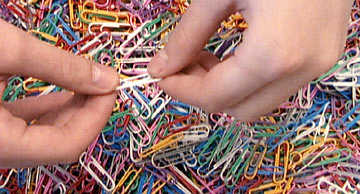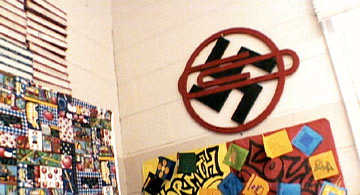Paper Clips


It's hard for anybody, especially a teenager to fathom a number like six million. Numbers that large are too abstract to make any sense. Six million Jews died in the Holocaust, but that number meant little to the students of Whitwell Middle School, located in the small town of Whitwell, Tennessee. Whitwell has around 2,000 citizens, and it nearly one hundred percent white and Christian. They had little to no experience dealing with blacks or Hispanics, and no first hand connection to the Holocaust. Principal Linda Hooper decided that she should start the project as a lesson in diversity. While there was no overt bias in Whitwell, many people found that they carried with them stereotypes and prejudices that were not right. Assistant Principal David Smith and teacher Sandra Roberts led the class, which came dealt with the Holocaust.
The class discovered that in World War II, Norwegians demonstrated their opposition to Nazism by wearing paper clips. This class would try to gather one paper clip for each Jewish person who died in the Holocaust, and this would serve as a great learning experience to the scope of the tragedy. Paper Clips, written by Joe Fab and directed by Fab and Elliot Berlin, is really two movies. The first half is extremely moving, and culminates with an emotionally packed visit from Holocaust survivors to the small town. In the second half, the tone changes slightly. Now, with their project complete, the students and advisors look at what to do next. While what they did is good, it feels very self-congratulatory. The movie becomes less about the project and its effect on the students and more on what the students are doing because of what they know. It's a very fine line, but Paper Clips crosses it.
The first half of the film talks about the origins of the project. Students wrote to politicians, celebrities, and anybody they could think of, telling them about their project and asking them to send a paperclip. Some sent a few, some sent a few thousand. Most came with letters, some of which were very touching and personal. The project was sometimes discouraging because they would go through dry spells where few clips would come in. Things really took off when German White House correspondents Peter and Dagmar Schroeder learned about the project. Their article about it brought lots of publicity, which brought in more paperclips and even more publicity, from outlets like the Washington Post and NBC. The students shattered their goal, and some survivors came and gave some emotional testimonies. Fab and Berlin should have stopped here. It's a very nice place to finish the story. Everything that takes place after that loses some of the luster.